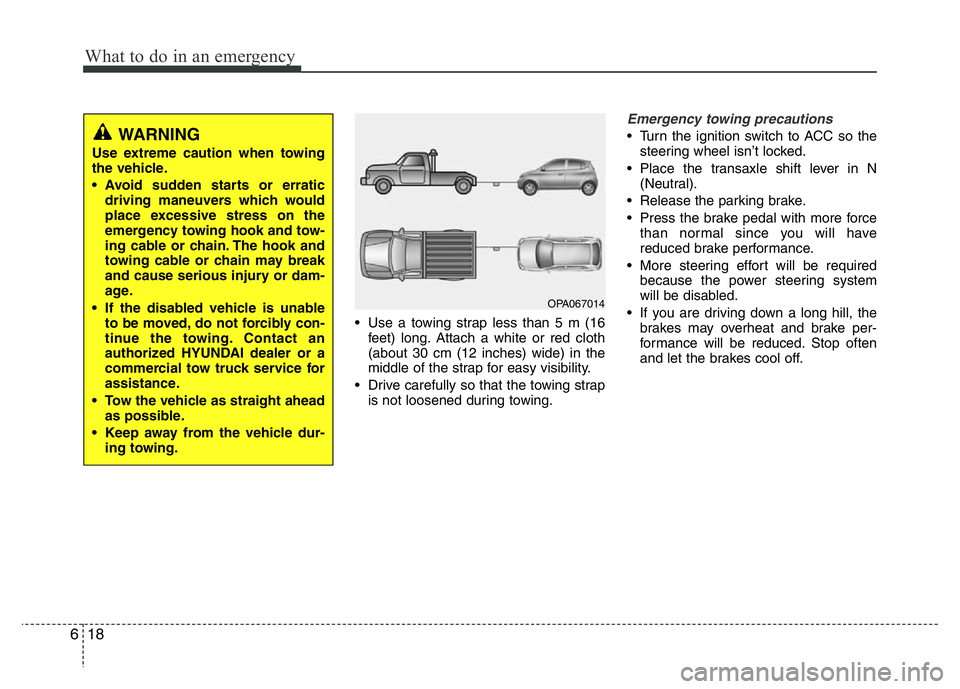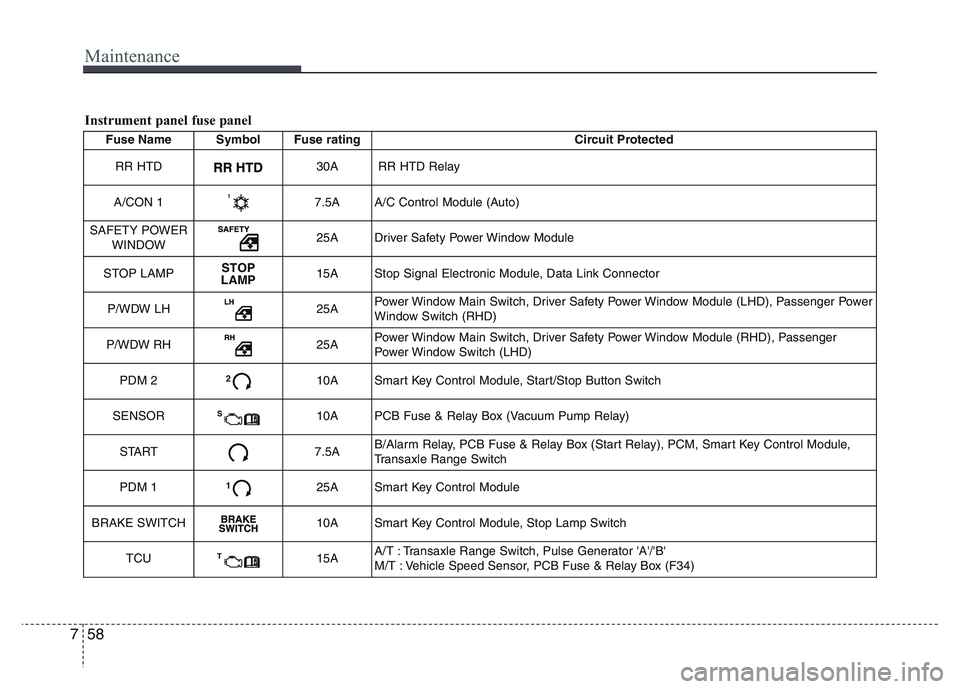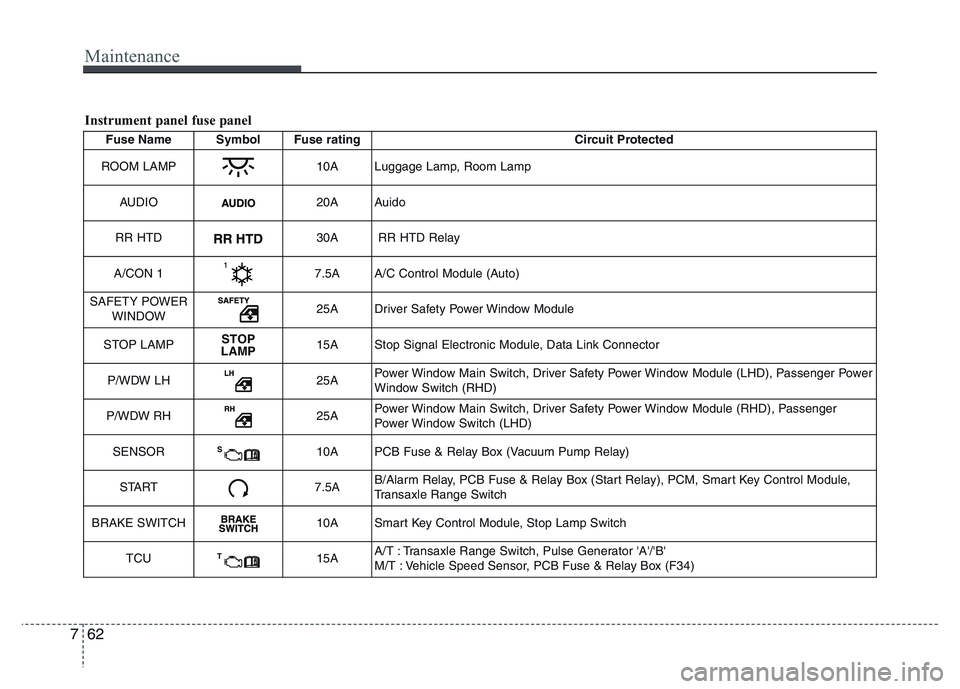stop start HYUNDAI I10 2014 Owner's Manual
[x] Cancel search | Manufacturer: HYUNDAI, Model Year: 2014, Model line: I10, Model: HYUNDAI I10 2014Pages: 343, PDF Size: 9.14 MB
Page 235 of 343

What to do in an emergency
2 6
ROAD WARNING
Hazard warning flasher
The hazard warning flasher serves as a
warning to other drivers to exercise
extreme caution when approaching,
overtaking, or passing your vehicle.It should be used whenever emergency
repairs are being made or when the vehi-
cle is stopped near the edge of a road-
way.
To turn the hazard warning flasher on or
off, press the hazard warning flasher but-
ton with the ignition switch in any posi-
tion. The button is located in the center
console switch panel. All turn signal
lights will flash simultaneously.
• The hazard warning flasher operates
whether your vehicle is running or not.
• The turn signals do not work when the
hazard flasher is on.
If the engine stalls at a crossroad
or crossing
• If the engine stalls at a crossroad or
crossing, set the shift lever in the N
(Neutral) position and then push the
vehicle to a safe place.
• If your vehicle has a manual transaxle
not equipped with a ignition lock
switch, the vehicle can move forward
by shifting to the 2(second) or 3(third)
gear and then turning the starter with-
out depressing the clutch pedal.
If you have a flat tire while driving
If a tire goes flat while you are driving:
1. Take your foot off the accelerator pedal
and let the vehicle slow down while
driving straight ahead. Do not apply the
brakes immediately or attempt to pull
off the road as this may cause a loss of
control. When the vehicle has slowed
to such a speed that it is safe to do so,
brake carefully and pull off the road.
Drive off the road as far as possible
and park on a firm level ground. If you
are on a divided highway, do not park
in the median area between the two
traffic lanes.
IN CASE OF AN EMERGENCY
WHILE DRIVING
OBA043027L
Page 236 of 343

63
What to do in an emergency
2. When the vehicle is stopped, turn on
your hazard warning flasher, set the
parking brake and put the transaxle in
P (automatic transaxle) or reverse
(manual transaxle).
3. Have all passengers get out of the
vehicle. Be sure they all get out on the
side of the vehicle that is away from
traffic.
4. When changing a flat tire, follow the
instruction provided later in this chap-
ter.
If the engine stalls while driving
1. Reduce your speed gradually, keeping
a straight line. Move cautiously off the
road to a safe place.
2. Turn on your hazard warning flasher.
3. Try to start the engine again. Try to
start the engine again. If your vehicle
will not start, we recommend that you
consult an authorized HYUNDAI deal-
er.
If the engine doesn't turn over or
turns over slowly
1. If your vehicle has an automatic
transaxle, be sure the shift lever is in N
(Neutral) or P (Park) and the emer-
gency brake is set.
2. Check the battery connections to be
sure they are clean and tight.
3. Turn on the interior light. If the light
dims or goes out when you operate the
starter, the battery is discharged.
4. Check the starter connections to be
sure they are securely tightened.
5. Do not push or pull the vehicle to start
it. See instructions for "Jump starting".
If the engine turns over normally
but does not start
1. Check the fuel level.
2. With the ignition switch in the LOCK/
OFF position, check all connectors at
the ignition coils and spark plugs.
Reconnect any that may be discon-
nected or loose.
3. Check the fuel line in the engine com-
partment.
4. If the engine still does not start, we rec-
ommend that you call an authorized
HYUNDAI dealer.
IF THE ENGINE DOES NOT START
WARNING
If the engine will not start, do not
push or pull the vehicle to start it.
This could result in a collision or
cause other damage. In addition,
push or pull starting may cause the
catalytic converter to overload and
create a fire.
Page 251 of 343

What to do in an emergency
18 6
• Use a towing strap less than 5 m (16
feet) long. Attach a white or red cloth
(about 30 cm (12 inches) wide) in the
middle of the strap for easy visibility.
• Drive carefully so that the towing strap
is not loosened during towing.
Emergency towing precautions
• Turn the ignition switch to ACC so the
steering wheel isn’t locked.
• Place the transaxle shift lever in N
(Neutral).
• Release the parking brake.
• Press the brake pedal with more force
than normal since you will have
reduced brake performance.
• More steering effort will be required
because the power steering system
will be disabled.
• If you are driving down a long hill, the
brakes may overheat and brake per-
formance will be reduced. Stop often
and let the brakes cool off.WARNING
Use extreme caution when towing
the vehicle.
• Avoid sudden starts or erratic
driving maneuvers which would
place excessive stress on the
emergency towing hook and tow-
ing cable or chain. The hook and
towing cable or chain may break
and cause serious injury or dam-
age.
• If the disabled vehicle is unable
to be moved, do not forcibly con-
tinue the towing. Contact an
authorized HYUNDAI dealer or a
commercial tow truck service for
assistance.
• Tow the vehicle as straight ahead
as possible.
• Keep away from the vehicle dur-
ing towing.
OPA067014
Page 310 of 343

Maintenance
58 7
Fuse Name Symbol Fuse rating Circuit Protected
RR HTD
30A RR HTD Relay
A/CON 1
7.5A A/C Control Module (Auto)
SAFETY POWER
WINDOW
25A Driver Safety Power Window Module
STOP LAMP
STOP
LAMP15A Stop Signal Electronic Module, Data Link Connector
P/WDW LH
25APower Window Main Switch, Driver Safety Power Window Module (LHD), Passenger Power
Window Switch (RHD)
P/WDW RH
25APower Window Main Switch, Driver Safety Power Window Module (RHD), Passenger
Power Window Switch (LHD)
PDM 2
210A Smart Key Control Module, Start/Stop Button Switch
SENSOR
S10A PCB Fuse & Relay Box (Vacuum Pump Relay)
START
7.5AB/Alarm Relay, PCB Fuse & Relay Box (Start Relay), PCM, Smart Key Control Module,
Transaxle Range Switch
PDM 1
125A Smart Key Control Module
BRAKE SWITCH
10A Smart Key Control Module, Stop Lamp Switch
TCU
T15AA/T : Transaxle Range Switch, Pulse Generator 'A'/'B'
M/T : Vehicle Speed Sensor, PCB Fuse & Relay Box (F34)
Instrument panel fuse panel
Page 314 of 343

Maintenance
62 7
Fuse Name Symbol Fuse rating Circuit Protected
ROOM LAMP
10A Luggage Lamp, Room Lamp
AUDIO
20A Auido
RR HTD
30A RR HTD Relay
A/CON 1
7.5A A/C Control Module (Auto)
SAFETY POWER
WINDOW
25A Driver Safety Power Window Module
STOP LAMP
STOP
LAMP15A Stop Signal Electronic Module, Data Link Connector
P/WDW LH
25APower Window Main Switch, Driver Safety Power Window Module (LHD), Passenger Power
Window Switch (RHD)
P/WDW RH
25APower Window Main Switch, Driver Safety Power Window Module (RHD), Passenger
Power Window Switch (LHD)
SENSOR
S10A PCB Fuse & Relay Box (Vacuum Pump Relay)
START
7.5AB/Alarm Relay, PCB Fuse & Relay Box (Start Relay), PCM, Smart Key Control Module,
Transaxle Range Switch
BRAKE SWITCH
10A Smart Key Control Module, Stop Lamp Switch
TCU
T15AA/T : Transaxle Range Switch, Pulse Generator 'A'/'B'
M/T : Vehicle Speed Sensor, PCB Fuse & Relay Box (F34)
Instrument panel fuse panel
Page 335 of 343

783
Maintenance
3. Exhaust emission control
system
The Exhaust Emission Control System is
a highly effective system which controls
exhaust emissions while maintaining
good vehicle performance.
Vehicle modifications
This vehicle should not be modified.
Modification of your vehicle could affect
its performance, safety or durability and
may even violate governmental safety
and emissions regulations.
In addition, damage or performance
problems resulting from any modification
may not be covered under warranty.
Engine exhaust gas precautions
(carbon monoxide)
• Carbon monoxide can be present with
other exhaust fumes. Therefore, if you
smell exhaust fumes of any kind inside
your vehicle, have it inspected and
repaired immediately. If you ever sus-
pect exhaust fumes are coming into
your vehicle, drive it only with all the
windows fully open. Have your vehicle
checked and repaired immediately.• Do not operate the engine in confined
or closed areas (such as garages) any
more than what is necessary to move
the vehicle in or out of the area.
• When the vehicle is stopped in an
open area for more than a short time
with the engine running, adjust the
ventilation system (as needed) to draw
outside air into the vehicle.
• Never sit in a parked or stopped vehi-
cle for any extended time with the
engine running.
• When the engine stalls or fails to start,
excessive attempts to restart the
engine may cause damage to the
emission control system.
WARNING- Exhaust
Engine exhaust gases contain car-
bon monoxide (CO). Though color-
less and odorless, it is dangerous
and could be lethal if inhaled.
Follow the instructions following to
avoid CO poisoning.